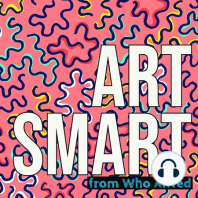4 min listen
The Principles of Design - Rhythm & Movement
FromArt Smart
ratings:
Length:
4 minutes
Released:
Feb 16, 2022
Format:
Podcast episode
Description
Much like scale and proportion, Rhythm and movement are related and I am going to lump them together for this episode. To start with, let’s define the terms. Movement is traveling from one location to another. Most works of art are not physically moving which can lead to confusion when people are told to consider movement in an artwork. While the artwork may not be moving, the viewer’s eye does move around the composition. That is the movement an artist must be mindful of. Line can be particularly helpful in controlling movement around a composition. The human eye naturally follows lines so artists will often create their work with leading lines that act as a pathway for the eye to follow around the work.
Rhythm is often discussed in music but visual artists are fond of appropriation and have thus coopted that term to describe a design principle that is felt but hard to express in words. This is a podcast dedicated to explaining these concepts though, so I will do my best to explain it. When we think of rhythm in music, we are talking about long and short notes and rests. In art, we might think of it as a combination of a couple of design principles affecting the way the eye moves around the composition. I have heard rhythm described as a repeated visual movement. While the central focus of rhythm is the experience of the movement, the pacing and all of that, I think it is important to be mindful that just as some notes move quickly and others are held, within our composition, some elements have greater weight and the eye will linger on those longer while others are not emphasized so much, and the eye will move more quickly past those. If we think of movement as the path the eye follows around the composition, rhythm is all about how the eye navigates that path. To labor this analogy, think of a road trip. The movement is the path marked on the map, but the rhythm is all about how fast you travel that path, and where you stop along the way. You might slow down briefly as you pass by the world’s largest ball of twine, but you would get out and take your time to explore a national park. So as you create those leading lines, think not only about where you are guiding the viewer’s eye to travel, but also how the eye will linger on pieces of different visual weight. You want to have some areas that are important where the eye can focus intensely and discover important details, but you also want to provide some rest areas to make it a more pleasant journey.
As always, you can find more at www.artsmartpodcast.com
Learn more about your ad choices. Visit megaphone.fm/adchoices
Rhythm is often discussed in music but visual artists are fond of appropriation and have thus coopted that term to describe a design principle that is felt but hard to express in words. This is a podcast dedicated to explaining these concepts though, so I will do my best to explain it. When we think of rhythm in music, we are talking about long and short notes and rests. In art, we might think of it as a combination of a couple of design principles affecting the way the eye moves around the composition. I have heard rhythm described as a repeated visual movement. While the central focus of rhythm is the experience of the movement, the pacing and all of that, I think it is important to be mindful that just as some notes move quickly and others are held, within our composition, some elements have greater weight and the eye will linger on those longer while others are not emphasized so much, and the eye will move more quickly past those. If we think of movement as the path the eye follows around the composition, rhythm is all about how the eye navigates that path. To labor this analogy, think of a road trip. The movement is the path marked on the map, but the rhythm is all about how fast you travel that path, and where you stop along the way. You might slow down briefly as you pass by the world’s largest ball of twine, but you would get out and take your time to explore a national park. So as you create those leading lines, think not only about where you are guiding the viewer’s eye to travel, but also how the eye will linger on pieces of different visual weight. You want to have some areas that are important where the eye can focus intensely and discover important details, but you also want to provide some rest areas to make it a more pleasant journey.
As always, you can find more at www.artsmartpodcast.com
Learn more about your ad choices. Visit megaphone.fm/adchoices
Released:
Feb 16, 2022
Format:
Podcast episode
Titles in the series (46)
Elements of Art: Texture: <p>This episode is about the Element of Art, Texture. The texture of a piece is referring to its surface quality. Texture has to do with the sense of touch. Artworks can have either real physical texture or an implied texture meaning it looks as if it might feel a certain way. </p> <p>If you enjoy the podcast, please follow and rate it on Spotify or wherever you get your podcasts. If you want to learn more about art and art history, check out my other podcast, <a href="https://open.spotify.com/show/1Sv71dnatL79dprwfX4Ypa?si=452fc15e35654a6a">Who ARTed</a>, where each week I cover a different artist and their work along with fun fact mini-episodes every Friday to give you an interesting story that isn't covered in the standard art history survey course.</p> <p>You can also find more information and resources at <a href="https://www.whoartedpodcast.com/">www.whoartedpodcast.com</a></p> <p><br></p> by Art Smart
